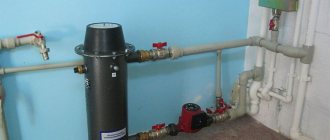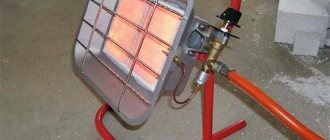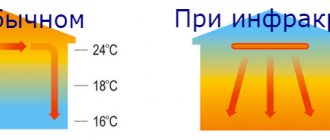What to consider when choosing a garage heating system
So, if the decision to heat the garage has been made, then you should not rush to the store to buy this or that type of heating equipment.
It will not make any sense if you do not take into account some points regarding the premises itself. First of all, we need to deal with the insulation of the building. If it is a metal structure, then it will have to be lined with brick on the outside or lined with insulation from the inside, covered with plywood or OSB boards on top. The first option is better. At the same time, it is necessary to insulate not only the walls, but also the roof, and, if possible, the floors. Although problems will arise with the latter in a used garage. Secondly, all possible leaks must be eliminated, especially for gates and windows. Because not only will cold air pass through them, but warm air will also evaporate.
Insulating the garage from the inside
The second thing you need to pay attention to when starting to think about heating is ventilation. Many will say that heat will escape through it to the street, and they will be right
But do not forget that various lubricants, sometimes fuel, are stored inside the garage, which emit vapors that are dangerous to humans into the room, and they must be disposed of. In addition, if a garage boiler is installed that runs on solid fuel or waste fuel, then no matter how high-quality it is, no matter how well the chimney works, carbon monoxide in small quantities will still penetrate into the room where it will begin to accumulate. And this is already bad.
A comment
Sergei Kharitonov
Leading engineer for heating, ventilation and air conditioning LLC "GK "Spetsstroy"
Ask a Question
“I’ll add that the ventilation functions will include reducing humidity. In winter or in rainy weather, a car will carry water and snow with it, which will create increased humidity inside the garage. It will cause the car to rust faster. So ventilation on all sides is a necessary engineering network.”
Fire safety requirements
The car itself is already an object of increased fire danger. Therefore, when the question of how to heat a garage is raised, it is necessary to adhere strictly to fire safety rules. Namely:
- You cannot store more than 20 liters of fuel in the garage, and 5 liters of oil. Their storage must be organized in a special container with a well-closed lid. The canisters themselves should be stored in a metal cabinet.
- You should not clutter the room with old things, because they are the sources of maintaining the fire.
A fire in a garage is not uncommon, follow the fire safety rules and requirements
- You cannot refuel your car inside the garage; this can only be done outside.
- The same goes for changing the oil.
- It is prohibited to turn the building into a washing facility for cleaning car parts and components in gasoline.
- Used rags should be thrown away immediately.
- Clothes are stored in a closet or other room.
- No hot work in the garage.
- You cannot light torches, fires, blowtorches or gas burners in it.
- Smoking is also strictly prohibited here.
- You cannot use homemade electrical appliances for heating.
- There must be a fire extinguisher in the garage; it must be located on the inner plane of the gate leaves. Near the building you need to organize a box with sand, a barrel of water and several tools: shovels, buckets and an ax.
It is prohibited to store fuel in large quantities in a garage.
As you can see, the question of how to heat a garage in winter with your own hands is not only a matter of choosing a heating technology and a heating device. This is a whole set of requirements from firefighters. Although these are the rules that apply to being safe in the garage. So don't argue with fire safety officials if they require you to strictly adhere to these standards.
Garage heating options
Based on the type of heating element, heating systems are divided into the following types:
- gas,
- electrical,
- solid fuel,
- liquid fuel.
Almost all car owners choose garage heating as the most economical way to heat a room. Therefore, we will consider all the options from the perspective of energy savings.
There are several ways to heat a garage, the best one is chosen based on the capabilities Source liveinternet.ru
Gas heating type
This term does not mean a gas pipe with methane inside. Garages use bottled liquefied gas. At the same time, according to fire safety requirements, the cylinders themselves must be stored outside the garage. And the connection to the heating equipment is made either with a steel pipe or a metallized gas hose.
As for savings, among all the options offered, this is one of the most economical. But there is one serious nuance here. If the garage is for one car, then you should not use a complex gas heating system. Even one wood-burning stove will be more economical. Because such garages are rarely heated, and heating with gas is a considerable initial investment of money.
You can purchase an infrared stove powered by gas. For small garages this is the best option: inexpensive, economical and mobile. If you choose the right power of the heating unit, then there will be no problems with heat supply in winter. Therefore, among the gas heating options, this is the best.
Infrared gas oven Source liveinternet.ru
See also: Contacts of companies that deal with home insulation.
Electrical
Electricity cannot be called an economical fuel. But for heating a garage in winter, this option is one of the best. Firstly, there is no need to carry out complex installation of communication networks. Only an outlet is required. Secondly, electricity is the most affordable type of energy carrier.
The only task of the garage owner is to find a device that would consume electric current economically.
- Infrared heaters. Their advantage is economical energy consumption with high thermal energy output. The downside is that of all electric heating devices, they are the most expensive.
- Convector type radiators. Inexpensive equipment, but consume more energy than IR heaters.
- Heat guns. Heating efficiency is one hundred percent. They are comfortable and quickly warm up garages, even metal ones. But they consume several times more current than convector radiators.
Note! The design of heat guns includes a fan that blows on the heating coils. It will raise dust from the floor. And this means a decrease in sanitary standards and a negative impact on human health.
Heat gun Source housechief.ru
Solid fuel
Firewood, sawdust, coal, peat - all these types of fuel emit thermal energy well. Plus, many of them are affordable energy sources. That's why many garage owners don't bother. The main task is to heat the room for several hours.
But we need to define one position. Solid fuel burns well, burning quickly, so its consumption is high. And this is a decrease in the level of efficiency. Therefore, today potbelly stoves and other boilers of this type are practically not used. For several years now, the market has been dominated by so-called long-burning boilers, the operating principle of which is based on the process of pyrolysis. This is when the fuel burns slowly with minimal access to oxygen. The main thermal energy comes from fuel gases burned in another compartment.
It is pyrolysis boilers that are the most economical among solid fuel boilers.
Pyrolysis boiler Source tisam.ru
Electric heating options
Recently, popular and efficient garage heating has been associated with the use of various electrical units. There are many different devices designed for heating and powered by electricity.
How to make a stove from a cylinder:
Electric convector
To inexpensively heat a garage in winter, recently, car enthusiasts very often use convectors. They have built-in heating elements that heat the cold air coming from below.
Such heating devices can be mounted using brackets to the wall or placed in a convenient place on legs. There are also convectors with a combined mounting method, which makes their use more mobile. It is worth noting some advantages of these designs:
- in a short time you can quickly heat a large area;
- automatic maintenance of the set temperature, which makes its use more economical;
- safe operation and easy maintenance;
- long-term operation;
- Possibility of use in rooms with high humidity.
Portable fan heater
Unlike a convector, the fan in such a device allows for rapid heating of the required area. The device is convenient because its light weight allows it to be installed anywhere.
Using the thermostat, you can set any heating temperature. The unit is equipped with an automatic shut-off in case of overheating or tipping over. Low and medium power devices are low cost, which makes their use more economical.
How to make your own heating:
When operating a fan heater in a room, it is necessary to create conditions to maintain air humidity. To do this, you can place a bucket of water next to it. The only drawback is its noisy operation, but if you lubricate its bearings in time, the rotation will become quieter.
Infrared heater
- This type appeared quite recently and is based on the use of innovative technology. To quickly warm up a garage in this way, you need to point the heater at nearby objects.
- Due to the influence of infrared rays, solid objects are heated, which, in turn, release heat into the surrounding air. They operate absolutely silently and are light in weight.
- Positive qualities of this device:
- economical energy consumption;
- easy controls;
- high security;
- environmental friendliness.
An infrared heater will help instantly warm up the garage.
The greatest efficiency from the operation of such devices can be obtained if they are aimed at large surfaces.
Fan heater - a simple and cheap option ↑
The design of the device is very simple, which ensures its reliability
When heating a garage with electricity, a fan heater is most often chosen. This is due to its mobility (the ability to install anywhere) and low cost. The equipment operates according to the following principle. The spiral or heating elements, which act as a heat exchanger, are heated by electricity. The fan draws air from the room and circulates it between heated elements. The air is heated by heating elements and enters the garage. Typically, a fan heater has two heating stages, which are characterized by power: 1 and 2 kW. The advantages of a fan heater as a method of heating a garage with electricity include:
A large selection of modifications allows you to choose the best option
Cost-effective: low cost of the device.
- Compact, mobile. The device has small dimensions and light weight. You can bring it to the garage with you, rearrange it to any place and turn it on in the desired part of the room.
- Quickly heats up the room. Due to the air forced by the fan, heating occurs faster than, for example, a convector.
- Ease of use.
- If necessary, you can change the heating intensity using the speed switch.
- Automatic operation is achieved by turning off automatically when a certain heating level is reached and turning on when cooling.
This is rightfully the most economical way to heat a garage with electricity, but it has a fan heater and disadvantages that are quite significant:
- Dries the air. It is not recommended to use for a long time.
- Due to dust particles getting on the heating elements and burning them, it emits an unpleasant odor.
- Heats the room unevenly. The temperature will be higher near the device.
- Produces noise during operation.
Popular brands : Scarlett, Timberk, Polaris. Price : from 1.5 thousand rubles
No. 1. Water heating system
The water heating system is organized in the garage by analogy with residential premises. The coolant is heated in the boiler, and then it passes through pipes and radiators, uniformly heating the entire garage room. After the heat supply stops, the pipes remain heated for another couple of hours. This is the main advantage of this system.
The main disadvantage is the complexity of the organization. In addition, the water in the heating circuit may freeze, so if the system will not be used in the coming days, it is better to drain the water. On the other hand, frequent water changes lead to rapid corrosion of pipes and radiators. To avoid this problem, it is better to use metal-plastic equipment. It is better not to use ordinary water in the heating system - it is replaced with antifreeze, a non-freezing coolant.
The complexity of the arrangement results in another drawback - the high price. The most economical way to heat a garage is to connect its circuit to a home boiler. The cost of general heating will increase, but it will still be cheaper than organizing an independent heating system.
If it is not possible to connect to your home system, you will have to install a separate boiler. It can run on different fuels. The following types of boilers are used in the garage heating system:
- An electric boiler is the easiest to install, extremely safe, but expensive to operate. Even if you are not worried about electricity bills, you should not use such boilers in areas with frequent power outages, power surges, or in regions with severe windy winters, because the wires may break, which will ultimately lead to freezing of the water in the system. If you do not manage to drain the water in time, the pipes may burst;
- gas boilers are used extremely rarely in garages, since not everywhere there is access to a gas pipeline. If the gas pipeline runs nearby, then you are very lucky - gas heating is inexpensive, and such systems are quite simple in terms of operation. The main thing is to follow safety precautions;
- boilers for liquid and solid fuel. You can choose a stove that runs on wood, coal, diesel or waste oil - it all depends on which resource is more accessible in your case. Solid fuel boilers require constant monitoring and frequent loading of fuel. Pyrolysis and pellet units are more convenient in this regard, but they are not cheap; the most economical option is a potbelly stove, which can also be used in a water heating system.
For all boilers, except electric ones, you will have to organize a chimney. In addition to the boiler, radiators, heating pipes and chimney pipes, you will need a circulation pump and an expansion tank. All this costs money, so using a hydronic heating system only makes sense in large garages. Often such heating is done at service stations and commercial auto repair shops. If the garage is small, then there is no point in organizing such a complex water heating system - this is an option for more or less spacious rooms where constant heating is required.
The operating principle of a water heating system is quite simple. The coolant heats up, passes through the pipes, gives off heat and returns to the boiler. The system can be one- or two-pipe. A single-pipe system is much easier to organize and cheaper; it is best suited for a small private garage. In this case, the heated coolant sequentially enters the radiators, i.e. in the first radiator the temperature will be higher than in the last, where the antifreeze reaches it already cooled down. The two-pipe system allows for more uniform heating, but much more materials will be needed.
Even if the garage is not attached to the house, but is located nearby, you can try to connect it to the home heating system, but there are limitations. The distance from the garage to the house should not be more than 20 m, and the pipes must be properly insulated.
If antifreeze is used as a coolant (a liquid that does not freeze even at -45C), then you must work with it carefully, because it is a toxic substance that becomes even more dangerous when heated. Antifreeze is not recommended for use in two-pipe systems
The coolant is replaced every 5 years.
Choosing a heating type for a garage - advantages and disadvantages
If it is possible to organize water heating with a central gas supply, then other options are not needed - this is the most economical and convenient option, but, unfortunately, it is not available to everyone.
In terms of initial costs, installing water heating from a central gas boiler is an expensive undertaking. Requires underground laying and insulation of pipes, installation of radiators and installation of pipes indoors.
Advice. Metal-plastic pipes are much more profitable and practical than metal ones. Installation of metal-plastic does not take much time and is cheaper than welding.
Heating a garage using a heated floor system is an economical and convenient option with central water gas heating. Radiators and pipes take up a lot of space, get dirty quickly, produce high heat consumption and there is no way to place convenient shelves for tools.
Metal-plastic pipes with coolant are mounted directly into the concrete screed and uniformly heat the entire room. Therefore, the entire heating system is reliably protected from mechanical damage and warms up the car from below.
Wood or diesel boiler
Today, the cost of firewood, coal and even used diesel fuel has increased significantly. And in many regions it is no longer possible to claim that it is more economical to use wood heating than electric heating.
A simple potbelly stove will be able to maintain above-zero temperatures in a small, insulated garage, but it needs to be heated regularly; not everyone has the time for this. Coal and diesel fuel mean dirt and soot, and a ton of coal will cost exactly the same as you would spend on electric heating.
To heat 1 m3 of water to 50°C using electrics, the cost will be approximately 135 rubles; using diesel fuel, the same heating will cost 170 rubles. Therefore, now diesel and even waste fuel boilers are becoming unprofitable.
For all solid fuel boilers it is necessary to install a chimney, which also entails additional costs. According to fire safety rules for heating equipment, the height of the pipe must be twice the height of the building.
Long-burning solid fuel pyrolysis boilers
Relatively new types of heating that require loading fuel briquettes every two days. But the boiler itself is expensive and the fuel for it is also not cheap. If you calculate the payback, then in ten years this option will pay for itself.
Therefore, for a garage it is better to opt for electric heating - clean, convenient and, thanks to modern automation, inexpensive.
Gas autonomous heaters
It is not recommended to use gas cylinders in the garage as heating equipment, even if all safety measures are followed. If you decide to choose this heating option, then choose a heater with a closed combustion chamber and ceramic elements. Additional automatic switching on and off will save fuel consumption.
Electric garage heating
The easiest way to heat a garage with electricity is to use a suitable heater, either purchased or homemade. If you don’t have the money to buy factory equipment, you can make it yourself. The simplest heating device is a goat heater, the most affordable, but also the most ineffective. It is done easily and simply - take some kind of non-flammable dielectric, and wrap a nichrome wire around it. Next, connect the electrical cable to the product and plug it into the outlet.
Among all the options for heating a garage, this option is considered the most dangerous - electricity is generally not a joke. Bare nichrome wire is used here, there is no insulation of any kind. Users may be burned or receive electric shock, and there is a risk of fire. It is prohibited to leave such heating unattended. And in general, you should not use such makeshift and extremely dangerous heaters.
Electric heating of the garage can be organized using factory heating devices:
Before you start choosing the type of heating, you should take care of at least minimal thermal insulation of the garage. Otherwise, the heat will simply go outside.
- Heat guns - they are extremely safe and provide quick heat injection into the garage. It only takes a few minutes to warm up the entire volume, after which the room will become warm. Minus – increased noise level;
- Infrared heaters are a modern solution that pleases with high efficiency. Infrared heating of the garage does not dry out the air and is not harmful to health. Simple IR heaters are used here, which heat not the air itself, but the surrounding objects, as a result of which they begin to emit heat;
- Electric convectors are a great way to heat a garage in winter and not have to worry about installing or manufacturing complex equipment;
- Electric boilers - in this case, classic water heating using an electric boiler is organized in the garage. A boiler for a garage is selected according to its area and heat losses, focusing on the formula 1 kW of heat per 10 sq. m. area.
Heating of the garage can also be organized using a homemade boiler - for this you will need an electric heating element of suitable power, which must be built into a metal pipe of one diameter or another. Next, bends are welded to the pipe, to which a water heating system with batteries is connected. By the way, these same batteries (heating registers) can be made independently using pipes with a diameter of 100 mm.
The main disadvantage of any electric garage heating is its high cost - electricity is quite expensive, which leads to high costs. The most economical way to heat with electricity is using IR heaters.
Using a heating element for heating a garage
If you are faced with the need to choose a tubular electric heater for heating your garage, then it would not hurt you to take a closer look at the following types:
- heater cauldrons for the garage (they will work great if you have heating batteries made of steel, aluminum or cast iron),
- having special timers that are responsible for turning off equipment and regulating heat,
- Cartridge type heating elements.
Heating element with timer
No matter what type of tubular electric garage heater is right for you when building a heating apparatus in a box, you will still need to follow the construction regulations.
According to the rules, heating elements cannot be installed horizontally. And the most correct place to install it can be considered the lower distribution fitting. This is the only way to heat the liquid in the radiator as much as possible. This could be oil, water and antifreeze. It is very convenient that the flow of liquid occurs completely freely, and the heating element does not interfere with this in any way.
Cartridge-type heating elements stand a little apart from other electric heaters because of their special shell, which allows them to be used together with any coolant in garage heating radiators.
Cartridge type heating element
When assembling a tubular electric heater with your own hands, you simply need to adhere to all safety standards. First of all, it is important to monitor the functioning of the mechanism.
If you are unable to install a tubular electric heater in your garage, you can use a device that automatically controls the heating and cooling levels. The use of a grounded socket when equipping your parking lot with an electric boiler is mandatory if the unit is connected to the electrical network.
Pros and cons of a heated garage
Heating in a metal garage during the cold season creates comfortable conditions for car repairs.
The advantages of a heated room include the following factors:
Properly executed heating of a metal garage allows you to create comfortable conditions for repairs, which is important when the premises are used frequently. It is easier to start a car engine in a warm environment because the engine oil will not become thicker. Due to the easier starting of the engine, its parts are subject to reduced wear. Heating the garage in winter allows you to wash your car without fear of the locks freezing.
Heating installations have several disadvantages. These include a number of points:
- Obligatory costs for electricity or other types of fuel.
- Some types of systems are quite expensive to install and maintain; they pay for themselves only after 4-6 years from the date of purchase.
- Increased fire danger, the need to comply with a number of rules during installation.
How to choose the type of garage heating?
Garage heating must correspond to the specifics of the room and be:
- Safe. Where there is a car, there are a lot of flammable substances, so it is necessary to minimize the possibility of their contact with an open flame. It is not advisable to install homemade stoves and burners using liquid fuel in the garage (of course, not all of them, but many are made in such a way that when boiling, the burning oil can splash out).
- Adapted to temperature changes. The garage has a large door and when it is opened once, most of the heated air escapes to the street.
- Autonomous. If the garage is located away from the house, heating should not depend on external conditions and resources.
- On available fuel. It is this condition that is relied upon when choosing a heater.
- Inexpensive. Since few people try to invest huge amounts of money in the garage, they prefer an economy class stove or heater.
- Easy to maintain. Most likely, the owner does not need unnecessary worries with regular cleaning of carbon deposits. The heat source should require minimal attention.
- Compact. The heater must be located at a certain distance from the car, not interfere with the movement of a person and not steal space for yourself or a supply of fuel.
In addition, the heater must be selected according to the size of the room, the presence or absence of an inspection hole and the time that the owner plans to spend here.
Air heating system for garage
Air heating is not as popular among garage owners as water heating, but with its help you can not only heat, but also ventilate the room.
The method consists of equipping the garage with an air duct with deflectors through which air is supplied, pumped by the fan of a heat gun or fan heater and additionally passed through an air filter.
The main advantage of air heating for a garage is the rapid simultaneous drying of the entire volume, which prevents the aggressive effects of moisture on the car and other furnishings.
To reduce heating costs, the owner is recommended to insulate the outside walls and ceiling of the garage, having previously sealed all the cracks and holes. For thermal insulation of walls, you can use foam sheets, and expanded clay for the ceiling and floor. The use of mineral wool slabs will require subsequent waterproofing
A properly selected garage heating system will not only ensure a comfortable temperature in the room, protect the enclosing structures from dampness, but also prevent the development of corrosion on the metal parts of the car, which is detrimental to equipment.
Electric heating
The simplest and relatively affordable method is electric heating, for the arrangement of which it is enough to purchase the appropriate equipment. A wide variety of options, mobility and compactness are the main advantages. However, costs will directly depend on the established electricity tariffs.
Before installing electric heating, you need to choose the most suitable device:
- Electric inverter
- Infrared heater
- Heat gun
Among the types of electric heating, the most effective is the inverter or “heater”. There are a huge number of models on the market that are installed on the floor or hung on the wall. They are quite compact, but at the same time very productive.
The approximate cost of an electric inverter is from 10 thousand rubles.
A compact and effective solution is the installation of IR heaters - a fairly powerful and productive device
However, paying attention to the rapid heating of the room, they are not able to cope with large areas. Negative aspects are also high energy consumption and prices for corresponding installations
Find out more about infrared heating
The average cost of an infrared heater is from 4 thousand rubles.
Heat guns are considered compact, efficient and convenient, capable of heating a garage space in the shortest possible time. They consist of a heater and a fan that dissipates heat into the environment. However, to connect such equipment, it is necessary to have a single-phase network with a large cross-section of the wire being laid or a 3-phase network (the latter is preferable).
The cost of heat guns is from 5 thousand rubles.
How to reduce heat loss and not go broke?
No heating system will be profitable and efficient if care is not taken to reduce heat loss. Heaters will waste a huge amount of energy resources. This is expensive and impractical, so you will have to insulate the gates, walls, floor and roof.
You can use expanded clay, polystyrene concrete, foil insulation, but the cheapest and most versatile option is polystyrene foam. It is suitable for insulating all structural elements.
It can also be used for thermal insulation of the floor, provided that a floating screed is made: polystyrene foam does not tolerate mechanical stress well, so it is filled with cement.
Foam is ideal for lining garage doors. The insulation is attached to a special sheathing, and the top is covered with external cladding - MDF boards, chipboard or plywood.
The ceiling, walls and garage doors are covered with polystyrene foam. There are two options - external or external wall decoration. Both are equally effective and allow for excellent thermal insulation of the building. The choice should be based on the convenience of the garage owner himself.
Organizing a heating system with your own hands
Before the heating installation process, it is necessary to prepare a drawing
Before starting the installation process, you need to prepare a drawing that will show the system components and record the details of the connection. If we are talking about gas heating, you will need to collect a package of documents, otherwise the design may be considered illegal. Then you need to select the equipment itself
To do this, it is important to take into account the power by calculating the area, heating rate, efficiency and other factors. After this, boiler equipment, pumps, ventilation, pipe laying and connection of devices to each other are installed
Then commissioning work is carried out, which makes it possible to check the serviceability of the devices, make sure that the power is correctly selected and, if necessary, correct errors.
Do-it-yourself garage heating: electricity
Electric heating today is quite expensive. But the garage does not require much heat - it is enough to maintain the temperature at +5 degrees, so with good insulation, an electric heater will not hurt your pocket. Such devices can be divided into two groups: those that transfer heat to the internal air through contact and infrared ones.
Heaters that transfer heat to the surrounding air through direct contact
Traditional representatives are oil and quartz heaters.
The disadvantage of these devices is that their surface, for safety reasons, cannot be heated to a high temperature, so they do not have high performance. A more efficient device is a convector.
Its body is, in fact, a vertically installed rectangular pipe, inside of which a heating element is placed.
The housing does not come into contact with the heating element, so it does not heat up much and you cannot get burned on it. But the heating element heats up to a temperature of 600 degrees, as a result of which a powerful stream of hot air blows from the convector, like from a fan.
You can quickly warm up your garage using a fan heater - it distributes warm air not by convection, but by force.
Thermal (infrared) emitters
The devices described above allow you to create an even microclimate throughout the garage, but if it is not insulated or constantly ventilated (for example, there is a welding station with powerful ventilation inside), they will be of little use.
In such a situation, the right solution would be to install an IR heater.
The spiral in it heats up to a red glow, as a result of which it becomes a source of powerful thermal radiation.
Thus, the device transfers heat not through the air, but directly to the user and other objects, so even in an open area with such a heater it will be warm.
IR radiation is not harmful - solar heat is of the same nature.
Heating for the garage is electric, a universal option is an infrared heater
The infrared heater also uses a hot spiral, but it does not dry out the air and is absolutely silent. First of all, you should pay attention to the following advantages:
- efficiency;
- simplicity;
- durability;
- harmless to humans.
Since heat transfer is carried out using radiation, the efficiency of the device decreases sharply with increasing distance to the heating element. One infrared heater will not be able to heat the garage evenly; you will have to use several. But if you need to create comfortable conditions in a small work area, an IR heater will do it quite quickly.
An example of correct installation of an IR heater
The main disadvantage of an IR heater is that the body gets very hot, so it is very important that it does not come into contact with flammable objects. In addition, you can get burned on it.
In general, an infrared heater is well suited for use in the garage, not only from time to time, but also constantly. If you are looking for electric heating for your garage, you should seriously consider this option.
Installation of a solid fuel boiler with air heating
Installation of a solid fuel boiler with air heating (without connecting the liquid circuit) is carried out as follows:
- Preparing the place where it will be installed. The walls and floor nearby (at a distance of at least 50 cm inclusive) are finished with non-combustible material. The ideal option is to install a box made of refractory bricks.
- Chimney installation. It is better to “cut” the hole for the pipe using a powerful hammer drill and a diamond bit for stone.
- Boiler installation. Recommended performance is about 10 kW. If a pyrolysis boiler is installed, then the chimney should be additionally insulated (otherwise soot will regularly accumulate in it).
- Fixing the boiler (using dowels on the plates on the bottom). A mandatory item that many people ignore. Fixation allows you to avoid distortions and depressurization with the chimney.
- Test warm-up (one fuel load). At the same time, the tightness of the connection with the chimneys and the absence of reverse draft are checked.
All work should be carried out in the warm season. In winter, it will not be possible to finish the walls or screed the floor (at temperatures below +10 degrees, building materials of this type lose their properties).
A solid fuel boiler can also be placed outside the garage in an extension; according to many criteria, this is more convenient. But in the garage itself, it is necessary to run a heating circuit or at least a radiator, heated by the boiler. The efficiency of such a system is much lower; part of the heat will be dissipated into the environment rather than entering the room.
Prices for gas convector
gas convector If the boiler is located outside, then a heating circuit with coolant or a radiator must be introduced into the garage
In summary, there are a lot of options for economical garage heating systems, but the most profitable option is to install a solid fuel boiler with air heating (popularly referred to as “potbelly stoves”), running on coal, fuel oil, wood or wood briquettes. In this case, one-time heating of a garage of 25 square meters will cost only 40–60 rubles.
Which option for electric garage heating to choose?
Which option for electrical heating equipment is more profitable? Let's consider the advantages and disadvantages of the proposed electric garage heating systems.
Stationary electric boiler and water heating
Types of electric boilers that can be installed in a garage:
- boilers on heating elements - several heating elements are installed in a thermally insulated tank, with automatic shutdown when the required coolant temperature is reached. You can make such a device yourself, and it will cost five times less. You will need a piece of metal pipe and three heating elements with different capacities of 1 and 2 kW. The figure shows how to make such a homemade mini electric boiler with your own hands using a welding machine and several fittings. Disadvantage - it takes a long time to warm up, large heat losses due to indirect heating of the coolant.
- boiler on electrodes - inside the thermally insulated heating tank there are two electrodes that instantly heat the medium due to the generated electromagnetic field. Therefore, the efficiency and speed of warming up will be maximum. Disadvantage - a special coolant is required - saline solution;
- induction boilers - the copper core inside the tank is heated by an alternating electromagnetic field created by Foucault currents (eddy electromagnetic flows). In terms of characteristics, such boilers are not much more economical than heaters on Tenakh, but are twice as expensive.
In terms of price, a good heating element and induction boiler costs about 40 - 50 thousand rubles, a homemade one will cost three thousand. Electrode boilers of the economy version cost from 10 to 15 thousand rubles.
Since 1 kW of electricity heats 10 m2, then for a garage of 20 square meters you need to take an electric boiler of 3 kW, since you need a power reserve.
According to reviews, the best boilers on Tenah are Teploteh, Evan EPO, Novel and Alvin EVP. Among induction boilers, the most trusted brands are SAV SPEC and SAV PROF. The best options for electrode boilers are the company Galan (Ochag and Vulcan).
In addition to the boiler, we also need to install pipe distribution throughout the garage. Therefore, experts recommend installing heated floors rather than radiators for reliability and heat savings.
Warm floor in the garage
Installation of a water heated floor - step by step:
- We lay a layer of waterproofing (polyethylene film or roofing felt) on the subfloor;
- fill the screed using a concrete mixture with heat-insulating additives;
- We lay foil insulation on the screed, the thickness of the insulation is small, 1 cm;
- over the insulation we make a mesh-reinforced layer of cement screed;
- We mount the water circuit directly to the reinforcing mesh with clamps. It is fashionable to lay pipes in a spiral or snake. The maximum length of the entire circuit is no more than 70 meters.
Now all that remains is to fill the final layer of the floor with a concrete mixture with strength-enhancing additives that protect the floor from temperature changes and the heavy weight of the car.
How to heat your house without going broke?
And really: how to do this? After all, heating tariffs, especially gas, remain the highest on the market to this day
If you pay attention to other methods and systems for heating a house, then if the calculations are incorrect, you can pay even more. Each of them has its own purpose and is used to achieve certain temperatures.
There will not always be 100% heat from gas heating in a private house; at the same time, the walls may not warm up completely if only convectors are used. Therefore, let's look at the different options so that by the end of the article we can decide how to heat the house in the best way.
Goal: to constantly maintain the temperature of a country house.
Regularly maintaining the temperature of the house during periods when there is no one in it at all is not an easy task. But solvable. Here are the consequences for a house without heating in winter:
- The water supply system is deteriorating.
- The pipes lose their usefulness the following year and it is necessary to invest in checking them.
- Condensation appears on the walls, which leads to mold and mildew.
And to achieve this goal, special automatically programmed thermostats were created. To heat your house in winter, you only need a standard outlet, because the device is plugged into it. Next, the devices will be turned on according to a schedule set by the owner of the house. In addition, if one of your relatives plans to spend the weekend in a country house, then indicate in advance the date and temperature that should be before their arrival. Another option for heating a house in such conditions is through remote control in applications installed on mobile devices.
Goal: quickly warm up the country house during your arrival.
To ensure that the house is warm upon arrival, in addition to automatic heating systems used while the owners are not at home, you can use other heating methods. Of course, you most likely won’t be able to turn them on remotely, but they will quickly reach the required temperature.
To do this, combine: convectors and stoves, fan heaters and oil heaters. You cannot focus on a specific type of heater. If you want to heat your home economically without harming your health, then you need to forget about using only one fan heater, which heats the air by drying the moisture. Dryness develops and you quickly want to open the window.










